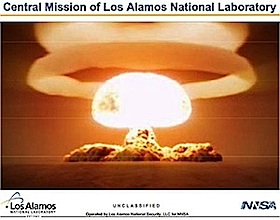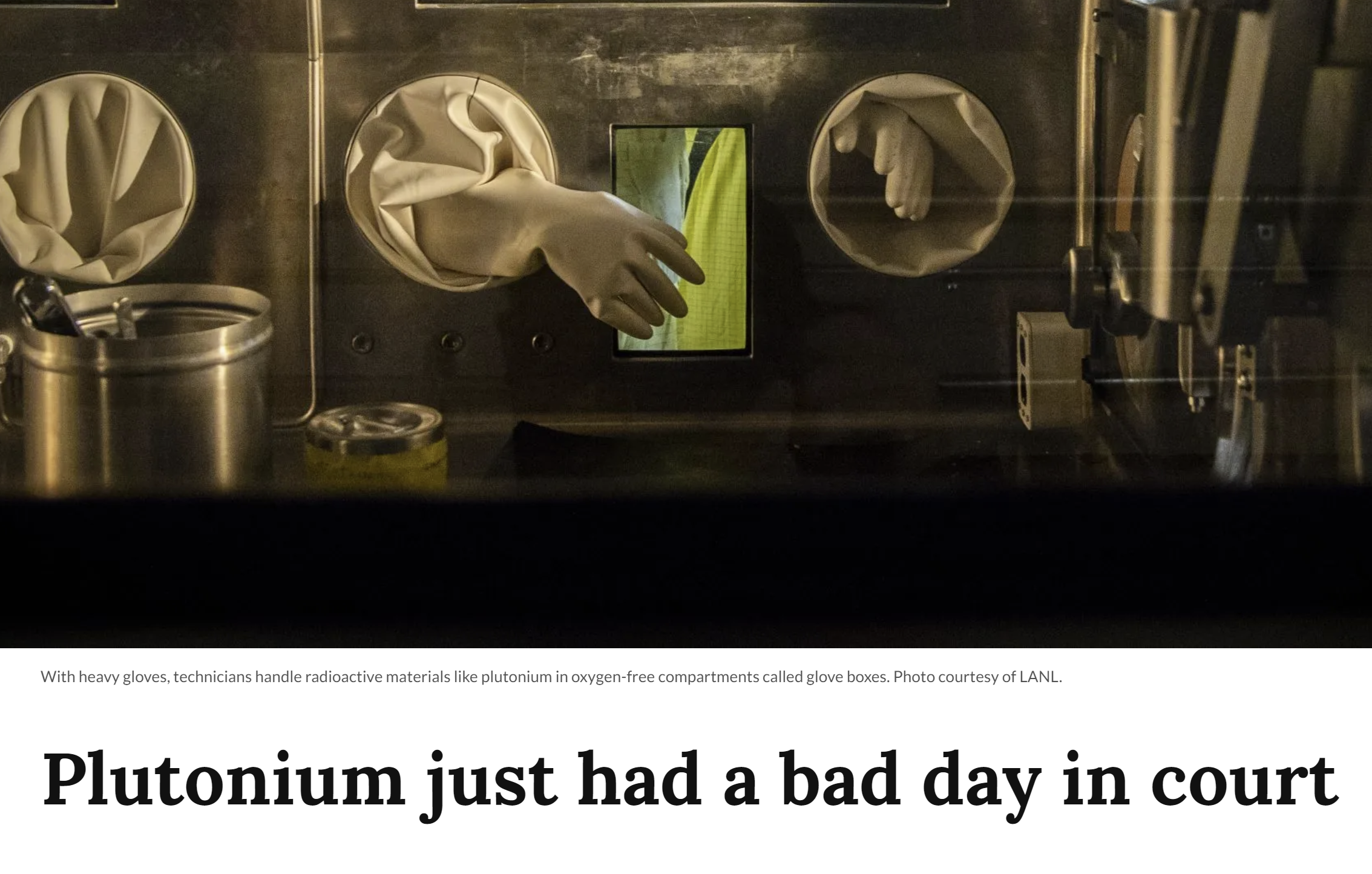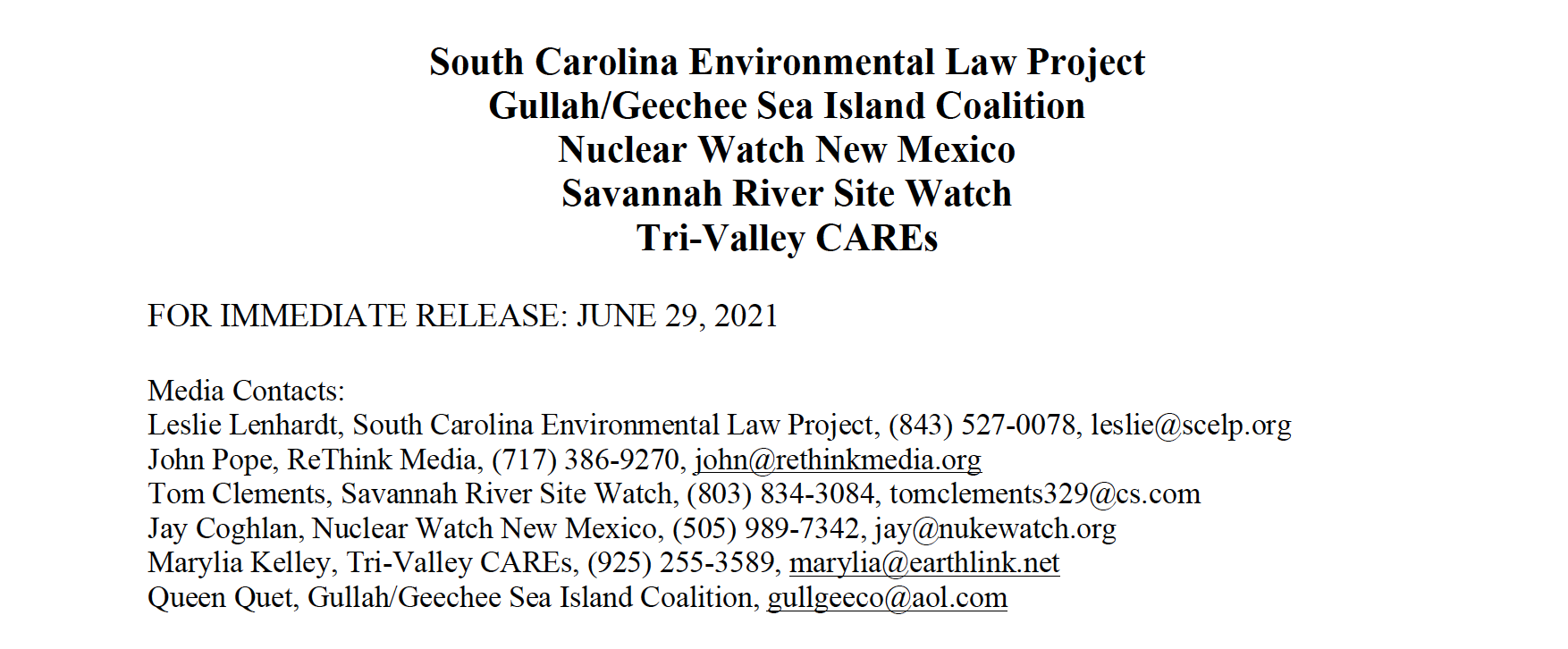Background
Nuclear Watch New Mexico is among a coalition of community and public interest groups that has filed a lawsuit against the U.S. Department of Energy (DOE) and the National Nuclear Security Administration (NNSA), challenging the federal agencies’ decision not to examine the possible wider impacts of Los Alamos National Laboratory and Savannah River Site in South Carolina producing these warhead triggers, also known as pits.
A plutonium pit is the heart and trigger of a nuclear bomb. Production involves the extensive processing and handling of extremely hazardous and radioactive materials. In 2018, the federal government called for producing at least 80 pits per year by 2030, including 30 or more at Los Alamos and 50 or more at the Savannah River Site.
We have pushed for a full program review since 2019, reaching out to DOE and NNSA on six occasions over the legal requirement for a new or supplemental broad, nationwide programmatic environmental impact statement, or PEIS, for producing the larger number of plutonium pits at Los Alamos and the Savannah River Site. NNSA has only conducted fragmented and piecemeal reviews, looking at sites separately rather than examining their combined impacts and risks.
Click below to view official lawsuit documents and recent media articles
Recent News
Historic Settlement Reached in NEPA Lawsuit Over Plutonium “Pit” Bomb Core Production
FOR IMMEDIATE RELEASE, January 17, 2025
Media Contacts:
Ben Cunningham, Esquire, SCELP, 843-527-0078, ben@scelp.org
Tom Clements, Savannah River Site Watch, 803-834-3084, tomclements329@cs.com
Jay Coghlan, Nuclear Watch New Mexico, 505-989-7342, jay@nukewatch.org
Scott Yundt, Tri-Valley CAREs, 925-443-7148, scott@trivalleycares.org
Queen Quet, Gullah/Geechee Sea Island Coalition, 843-838-1171, GullGeeCo@aol.com
AIKEN, S.C. — Nonprofit public interest groups have reached an historic settlement agreement with the Department of Energy’s semi-autonomous nuclear weapons agency, the National Nuclear Security Administration (NNSA). This is the successful result of a lawsuit against NNSA over its failure to complete a programmatic environmental impact statement on the expanded production of plutonium “pit” bomb cores, as required by the National Environmental Policy Act (NEPA). This agreement and a joint motion to dismiss have been submitted to Judge Mary Lewis Geiger of the Federal District of South Carolina. Should the Court enter the dismissal and retain jurisdiction to enforce the settlement, the agreement will go into effect.
This lawsuit was first filed in June 2021 by co-plaintiffs Savannah River Site Watch of Columbia, SC; Nuclear Watch New Mexico of Santa Fe, NM; Tri-Valley Communities Against a Radioactive Environment (CAREs), based in Livermore, CA; and the Gullah/Geechee Sea Island Coalition of coastal Georgia. NNSA promptly moved to have the case dismissed which in February 2023 Judge Lewis rejected, calling her decision “not a close call.”
View more info and browse our wonderful lawyers' website at scelp.org
LANL’s Central Mission: Los Alamos Lab officials have recently claimed that LANL has moved away from primarily nuclear weapons to “national security”, but what truly remains as the Labs central mission? Here’s the answer from one of its own documents:
LANL’s “Central Mission”- Presented at: RPI Nuclear Data 2011 Symposium for Criticality Safety and Reactor Applications (PDF) 4/27/11
Recent Documents
PLAINTIFFS OPENING BRIEF (MAY 3, 2024)
PLAINTIFFS’ INITIAL BRIEF: Savannah River Site Watch, Tom Clements, The Gullah/Geechee Sea Island Coalition, Nuclear Watch New Mexico and Tri-Valley Communities Against a Radioactive Environment
Declaration of Scott Yundt to Opening Brief
Declaration of Jay Coghlan to Opening Brief
Declaration of Tom Clements to Opening Brief
DEFENDANT’S RESPONSE BRIEF (JUNE 4, 2024)
DEFENDANTS’ BRIEF SEEKING JUDGMENT AND RESPONDING TO PLAINTIFFS’ OPENING BRIEF
Declaration of NNSA Administrator Jill Hruby to Opening Brief
Declaration of Carlsbad Field Office Manager Mark Bollinger to Opening Brief
Declaration of Carl Raymond Sykes to Opening Brief
Declaration of Idaho Cleanup Project Manager Mark C. Brown to Opening Brief
Declaration of Patrick Moss to Opening Brief
PLAINTIFFS REPLY BRIEF (JUNE 27, 2024)
PLAINTIFFS’ REPLY BRIEF: Savannah River Site Watch, Tom Clements, The Gullah/Geechee Sea Island Coalition, Nuclear Watch New Mexico and Tri-Valley Communities Against a Radioactive Environment
Declaration of Don R. Hancock in Support of Plaintiffs’ Brief in Reply
DEFENDANT’S SURREPLY – (JULY 12, 2024)
DEFENDANTS’ SUR-REPLY
COURT'S JUDGEMENT AND FINAL ORDER – (SEPT 30, 2024)
COURT'S JUDGEMENT
COURT'S FINAL ORDER
FINAL DECLARATIONS – 2024
Second Declaration of Jill Hruby 12-5-24
Gen Cotton Declaration 13 Nov 2024
Nuclear Pits - Dr Adams Declaration 12-12-24
FINAL SETTLEMENT AGREEMENT – (JAN 16, 2025 )
SRS Mot D Prop Order
SRS Joint Mot Dismiss
Settlement Agreement and Exhibits
FINAL JUDGEMENT – (FEB 14, 2025 )
SRS Judgment
SRS Order Dismissal
GENERAL DOCUMENTS
NNSA failed to respond to this notice, and the following lawsuit was filed:
Lawsuit filed against NNSA for failure to prepare a Programmatic EIS (PEIS) on plutonium pit production (for nuclear weapons), June 29, 2021 – by South Carolina Environmental Law Project (SCELP), for SRS Watch, Nuclear Watch New Mexico and Tri-Valley CAREs
Complaint filed, June 29, 2021: complaint with case number marking June 29 2021
RULE 26 INTERROGATORIES, June 29, 2021: RULE 26 INTERROGATORIES June 29 2021
| 07/01/2021 | 4 | Summons Issued as to United States Department of Energy, U.S. Attorney, and U.S. Attorney General. (cbru, ) (Entered: 07/01/2021) document 4 July 1 2021 Summons Issued as to United States Department of Energy, U.S. Attorney, and U.S. Attorney General. |
| 07/01/2021 | 5 | Summons Issued as to Jennifer Granholm, U.S. Attorney, and U.S. Attorney General. (cbru, ) (Entered: 07/01/2021) document 5 July 1 2021 summons to Sec Granholm |
| 07/01/2021 | 6 | Summons Issued as to National Nuclear Security Administration, U.S. Attorney, and U.S. Attorney General. (cbru, ) (Entered: 07/01/2021) document 6 July 1 2021 summons issued to NNSA |
| 07/01/2021 | 7 | Summons Issued as to Charles Verdon, U.S. Attorney, and U.S. Attorney General. (cbru, ) (Entered: 07/01/2021) document 7 July 1 2021 summons issued to NNSAs Charles Verndon |
Affidavit of Service – by SCELP to DOE, NNSA, federal attorneys, July 30, 2021: Affadavit of Service by SCELP to DOE, NNSA July 30 2021
Related Media
Historic Settlement Reached in NEPA Lawsuit Over Plutonium “Pit” Bomb Core Production
FOR IMMEDIATE RELEASE, January 17, 2025
Media Contacts:
Ben Cunningham, Esquire, SCELP, 843-527-0078, ben@scelp.org
Tom Clements, Savannah River Site Watch, 803-834-3084, tomclements329@cs.com
Jay Coghlan, Nuclear Watch New Mexico, 505-989-7342, jay@nukewatch.org
Scott Yundt, Tri-Valley CAREs, 925-443-7148, scott@trivalleycares.org
Queen Quet, Gullah/Geechee Sea Island Coalition, 843-838-1171, GullGeeCo@aol.com
AIKEN, S.C. — Nonprofit public interest groups have reached an historic settlement agreement with the Department of Energy’s semi-autonomous nuclear weapons agency, the National Nuclear Security Administration (NNSA). This is the successful result of a lawsuit against NNSA over its failure to complete a programmatic environmental impact statement on the expanded production of plutonium “pit” bomb cores, as required by the National Environmental Policy Act (NEPA). This agreement and a joint motion to dismiss have been submitted to Judge Mary Lewis Geiger of the Federal District of South Carolina. Should the Court enter the dismissal and retain jurisdiction to enforce the settlement, the agreement will go into effect.
This lawsuit was first filed in June 2021 by co-plaintiffs Savannah River Site Watch of Columbia, SC; Nuclear Watch New Mexico of Santa Fe, NM; Tri-Valley Communities Against a Radioactive Environment (CAREs), based in Livermore, CA; and the Gullah/Geechee Sea Island Coalition of coastal Georgia. NNSA promptly moved to have the case dismissed which in February 2023 Judge Lewis rejected, calling her decision “not a close call.”
Searchlight NM: Plutonium just had a bad day in court
In a major decision whose consequences are still being assessed, a federal judge declared that plutonium pit production — one ingredient in the U.S. government’s $1.5 trillion nuclear weapons expansion — has to be performed in accordance with the nation’s strongest environmental law
“…The court found that the agencies charged with reviving the nuclear weapons complex have not properly evaluated the perils that could come with turning out plutonium pits at two different sites, thousands of miles apart. For the plaintiffs in this case — which include Nuclear Watch New Mexico, Savannah River Site Watch, Tri-Valley Communities Against a Radioactive Environment and the Gullah/Geechee Sea Island Coalition — Lewis’s decision to intervene is a milestone.”
“We’ve had a pretty significant victory here on the environmental front,” said Tom Clements, the director of Savannah River Site Watch. “Nonprofit public interest groups are able to hold the U.S. Department of Energy accountable.”
Over the past twenty-plus years, there have been four attempts by NNSA to expand pit production through the NEPA process. All failed. According to Jay Coghlan, executive director of Nuclear Watch New Mexico, this string of defeats could have led to the NNSA’s circumvention of the NEPA process during this round of planning for pit production. Adhering to the rules of the NEPA process, he added, “benefits both the public and the government.”
By Alicia Inez Guzmán, Searchlight New Mexico | October 17, 2024 searchlightnm.org
Most Americans don’t seem aware of it, but the United States is plunging into a new nuclear arms race. At the same time that China is ramping up its arsenal of nuclear weapons, Russia has become increasingly bellicose. After a long period of relative dormancy, the U.S. has embarked on its own monumental project to modernize everything in its arsenal — from bomb triggers to warheads to missile systems — at a cost, altogether, of at least $1.5 trillion.
Los Alamos National Laboratory plays a vital role as one of two sites set to manufacture plutonium “pits,” the main explosive element in every thermonuclear warhead. But as a recent court ruling makes clear, the rush to revive weapons production has pushed environmental considerations — from nuclear waste and increases in vehicular traffic to contamination of local waterways, air and vegetation — to the wayside.
Court Rules U.S. Nuclear Weapons Production Plan Violates Federal Law
FOR IMMEDIATE RELEASE, October 3, 2024
Media Contacts:
Ben Cunningham, Esquire, SCELP, 843-527-0078, ben@scelp.org
Tom Clements, Savannah River Site Watch, 803-834-3084, tomclements329@cs.com
Jay Coghlan, Nuclear Watch New Mexico, 505-989-7342, jay@nukewatch.org
Scott Yundt, Tri-Valley CAREs, 925-443-7148, scott@trivalleycares.org
Queen Quet, Gullah/Geechee Sea Island Coalition, 843-838-1171, GullGeeCo@aol.com
AIKEN, S.C. — On September 30, United States District Court Judge Mary Geiger Lewis ruled that the United States Department of Energy (“DOE”) and its semi-autonomous nuclear weapons agency, the National Nuclear Security Administration (“NNSA”), violated the National Environmental Policy Act (“NEPA”) by failing to properly consider alternatives before proceeding with their plan to produce plutonium pits, a critical component of nuclear weapons, at the Los Alamos National Laboratory (“LANL”) in New Mexico and, for the first time ever, at the Savannah River Site (“SRS”) in South Carolina.
The Court found that the plan’s purpose had fundamentally changed from NNSA’s earlier analyses which had not considered simultaneous pit production at two sites. These changes necessitated a reevaluation of alternatives, including site alternatives, which Defendants failed to undertake prior to moving forward while spending tens of billions of taxpayers’ dollars. Therefore, the Court entered judgment in favor of Plaintiffs, the nonprofit public interest groups Savannah River Site Watch, Nuclear Water New Mexico and Tri-Valley Communities Against a Radioactive Environment (CAREs); the Gullah/Geechee Sea Island Coalition; and Tom Clements as an individual plaintiff.
As a result of this ruling, the Defendants are required to newly assess pit production at a nation-wide programmatic level which will mean undertaking a thorough analysis of the impacts of pit production at DOE sites throughout the United States, including radioactive waste generation and disposal. Under the National Environmental Policy Act (NEPA), this will provide the opportunity for public scrutiny of and formal comment on their assessments.
The Energy Department just made one plutonium pit. Making more is uncertain
Coinciding with NNSA’s announcement of the first diamond-stamped pit, a US District Court ruled that the Energy Department and the NNSA violated the National Environmental Policy Act (NEPA) by failing to properly consider alternatives before proceeding with pit production, requiring the agency to conduct a programmatic environmental impact assessment.
This was a victory for transparency and the community groups—among them, Savannah River Site Watch, Nuclear Watch New Mexico, Tri-Valley Communities Against a Radioactive Environment (CAREs), and the Gullah/Geechee Sea Island Coalition—who, for years, have been asking for such an assessment.
By Dylan Spaulding, The Bulletin of Atomic Scientists | October 10 thebulletin.org
Two conflicting developments arose this month in US efforts to produce new plutonium pits for its nuclear weapons: The National Nuclear Security Administration (NNSA) announced it had produced a warhead-ready pit—the explosive core of a nuclear weapon—for the first time in decades, and a federal court ruled that NNSA will be required to consider the cumulative environmental and health impacts of its pit production program.
Overshadowing these events is a vigorous debate over the necessity for new pits at all. Previous analyses have found that plutonium pits have viable lifespans well beyond the expected service life of the current stockpile, whereas production of pits for new weapons is part of a sweeping US nuclear modernization that raises concern over the future of arms control and any possibility for stockpile reductions at a time of deteriorating international relations.
Continue reading
Judge finds plutonium production plans violated environmental laws
Both sides of the case are ordered to present a joint plan to address violations by Oct. 25
One of the plaintiffs, Jay Coghlan, the executive director of Nuclear Watch New Mexico called that a “pretty large hurdle to overcome,” for both parties. It’s unclear what happens if the parties fail to present a joint solution.
By: Danielle Prokop – Source NM | October 8 sourcenm.com
U.S. energy officials illegally neglected to study impacts to the environment in efforts to increase plutonium production for nuclear weapons in New Mexico and South Carolina, a federal judge has ruled.
South Carolina District Court Judge Mary Geiger Lewis sided with environmental, anti-nuclear proliferation and community groups last week who sued the National Nuclear Security Administration (NNSA), which oversees the nuclear weapons stockpile as part of the U.S. Department of Energy.
The U.S. is investing billions into restarting the manufacture of plutonium “pits,” the grapefruit-sized spheres developed for nuclear weapons. The federal government halted its manufacturing program at the Rocky Flats Plant in Colorado in 1989 after an FBI raid due to safety concerns and environmental crimes.
The stated goal has been to produce 80 pits per year starting in 2030, split between Savannah River facility proposed in South Carolina and at Los Alamos National Laboratory in New Mexico. The project has faced safety concerns and delays. The Government Accountability Office, a federal watchdog agency, found the NNSA had no comprehensive timeline or cost estimate for pit production, but estimates it’s in the tens of billions of dollars.
Community, environment and anti-nuclear groups brought the lawsuit in 2021, alleging that the NNSA failed to consider alternatives to its two-site proposal and violated the law by not reviewing or changing its last analysis from 2008, when it approved the decisions to move forward in 2020.
Continue reading
U.S. Nuclear Weapons Sites Violated Rules, Judge Finds
In a statement Jay Coghlan, the director of Nuclear Watch New Mexico and a co-plaintiff in the lawsuit, said, “These agencies think they can proceed with their most expensive and complex project ever without required public analyses and credible cost estimates.”
By Matthew Impelli, Newsweek | October 4 newsweek.com
A federal judge ruled this week that some nuclear weapons sites in the U.S. do violate environmental regulations.
On Thursday, a federal judge ruled that the National Nuclear Security Administration violated environmental regulations by failing to adequately assess the environmental impact of its plan to expand plutonium pit production at facilities in South Carolina and New Mexico.
The case involves a lawsuit that targeted a 2018 plan to establish two plutonium pit production sites—one at South Carolina’s Savannah River and the other at Los Alamos National Laboratory in New Mexico. Plaintiffs argued the plan was based on an outdated environmental impact study, which failed to properly assess the implications of simultaneous production at both locations. They also insisted the plan weakened safety and accountability measures for the multibillion-dollar nuclear weapons program and its associated waste disposal.
In the ruling on Thursday, Judge Mary Geiger Lewis said, “Defendants neglected to properly consider the combined effects of their two-site strategy and have failed to convince the court they gave thought to how those effects would affect the environment.”
‘Significant Victory’: Court Rules Planned Plutonium Pits for New Nukes Violate US Law
“Public scrutiny is especially important because the activities at issue here, by their very nature, result in the production of dangerous weapons and extensive amounts of toxic and radioactive waste,” a plaintiffs’ lawyer said.
By Olivia Rosane, CommonDreams | October 3 commondreams.com
In what advocates called a major win for frontline communities and the rule of law, a U.S. district court judge ruled on Monday that the federal government could not move forward with producing plutonium pits—”the heart and trigger of a nuclear bomb“—at two proposed sites in New Mexico and South Carolina.
Instead, Judge Mary Geiger Lewis agreed with a coalition of nonprofit community groups that the Department of Energy (DOE) and the National Nuclear Security Administration (NNSA) violated the National Environmental Policy Act (NEPA) by failing to fully consider alternatives to producing the pits at New Mexico’s Los Alamos National Laboratory and South Carolina’s Savannah River Site (SRS). Now, the federal government must conduct a full environmental impact statement of how pit production would work at sites across the U.S.
“This is a significant victory that will ensure NEPA’s goal of public participation is satisfied,” attorney for the plaintiffs Ben Cunningham, of the South Carolina Environmental Law Project, said in a statement. “Public scrutiny is especially important because the activities at issue here, by their very nature, result in the production of dangerous weapons and extensive amounts of toxic and radioactive waste. I hope the public will seize the upcoming opportunity to review and comment on the federal agencies’ assessment.”
Biden Nominee to Lead Civilian Nuclear Weapons Office Gets His Hearing; Supports Review of Warhead Trigger Program
Nuclear Watch New Mexico, Tri-Valley CAREs and Savannah River Site Watch are in the process of suing for a programmatic environmental impact statement to be completed on plutonium “pit” (warhead trigger) production.
By Dan Leone | | March 22, 2022 DEFENSE DAILY defensedaily.com
In a confirmation hearing Tuesday morning, the Biden administration’s nominee to lead the National Nuclear Security Administration’s (NNSA) weapons programs from headquarters in Washington pledged his support for the agency’s program of record and agreed to review the agency’s plan to produce new plutonium pits if confirmed.
The nominee, Marvin Adams, a professor of nuclear engineering at Texas A&M University, testified alongside three other witnesses before the Senate Armed Services Committee. Adams appeared before the committee about 10 weeks after the Biden administration sent his nomination to the Senate. The White House announced its intent to nominate Adams in mid-December.
Groups Fire Back at Feds’ Move to Dismiss Plutonium Pit Lawsuit
Federal agencies continue to reject a full review of the public safety and environmental risks of producing nuclear bomb cores at multiple DOE sites.
Jay Coghlan, director of Nuclear Watch New Mexico, commented, “The government has yet to explain to American taxpayers why it will spend more than $50 billion to build new plutonium pit bomb cores for new-design nuclear weapons when we already have thousands of existing pits proven to be reliable for a century or more. This has nothing to do with maintaining the safety and reliability of the existing stockpile and everything to do with building up a new nuclear arms race that will threaten the entire world.”
SRS WATCH / EIN PRESSWIRE October 26, 2021
AIKEN, SOUTH CAROLINA — Public interest groups shot back at the U.S. Department of Energy and the National Nuclear Security Administration’s attempt to suppress a lawsuit seeking a comprehensive environmental review of the agencies’ plans to produce large quantities of nuclear bomb cores, or plutonium pits, at DOE sites in New Mexico and South Carolina.
Lawsuit Filed Against Biden Administration Over Nuclear Bomb Core Production Plans
Federal agencies’ refusal to review cross-country expansion of plutonium pit production violates the National Environmental Policy Act and the Administrative Procedures Act, groups say.
AIKEN, S.C. – Today, a coalition of community and public interest groups filed a lawsuit against the U.S. Department of Energy (DOE) and the National Nuclear Security Administration (NNSA). This legal action is prompted by the agencies’ failure to take the “hard look” required by the National Environmental Policy Act at their plans to more than quadruple the production of plutonium pits and split their production between the Los Alamos National Laboratory in New Mexico and the Savannah River Site in South Carolina.
Feds face suit over plan to build atomic weapons component factory in SC
VIEW NEWS CONFERENCE & PRESS RELEASE ABOVE
(also archived on the Facebook page of the South Carolina Environmental Law Project: https://www.facebook.com/scelp.org)
BY: SAMMY FRETWELL
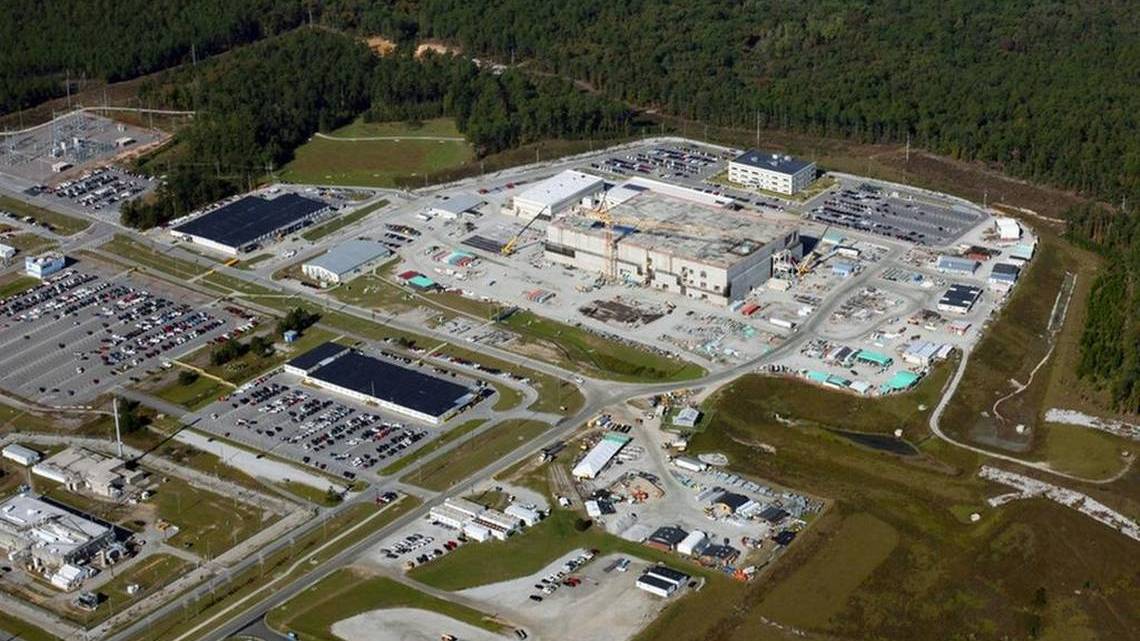
Four public interest groups said Tuesday they are suing the federal government, seeking to stop construction of multi-billion dollar nuclear production factories in South Carolina and New Mexico that would make components for new atomic weapons.
Savannah River Site Watch, Nuclear Watch New Mexico, Tri Valley CARES and the Gullah Geechee Sea Island Coalition are seeking an extensive study, known as a programmatic environmental impact statement, to weigh the effects of new pit plants on the environment and people who live near them.
Federal officials have sought the new plants to update the nuclear arsenal, a prospect that project boosters say could provide 1,000 jobs at the Savannah River Site, the Aiken area weapons complex where a pit factory would be located.
But critics say the promise of jobs isn’t worth the risk of environmental contamination or the cost, now estimated to be about $15 billion for the two plants.
MEDIA ADVISORY – South Carolina Environmental Law Project and Nuclear Watchdogs Hold Virtual Press Conference
WHAT:
Public interest groups will hold a press conference for a major announcement of a forthcoming legal action as the U.S. Department of Energy and the National Nuclear Security Administration forge ahead with plans to drastically expand production of plutonium pits, the cores of nuclear weapons, at the Savannah River Site in South Carolina and the Los Alamos National Lab in New Mexico. The legal action follows previous unanswered requests from the groups to DOE and NNSA as seen in correspondence in February and April.
Minorities threatened by atomic weapons plants in S. Carolina and NM, groups say
“As construction problems mounted, costs rose, and schedules slipped, (and) defendants hid the true status of the project,” the indictment said.
“…Delays and cost overruns — hidden by SCANA officials from the public and state regulators — eventually doomed the effort, making it one of the largest business failures in South Carolina history.”
BY SAMMY FRETWELL | April 22, 2021 thestate.com
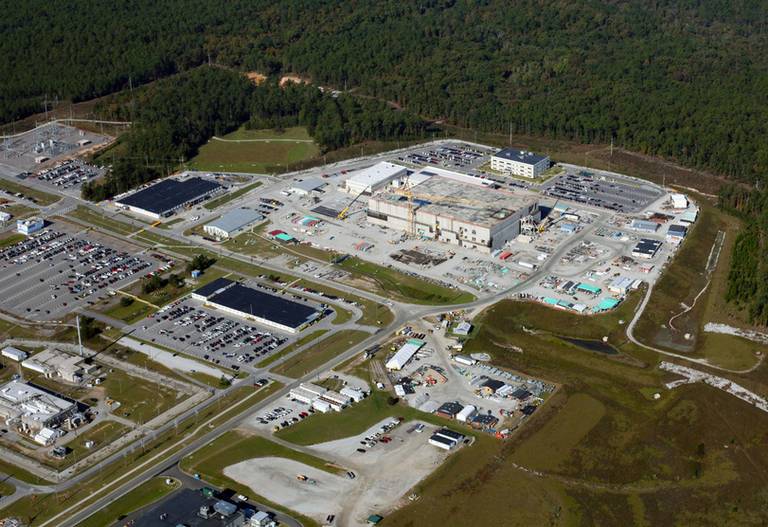
A coalition of environmental groups from the southern and western United States is threatening to sue the federal government over plans for plutonium pit factories in South Carolina and New Mexico that would produce components for additional atomic weapons.
In a letter Tuesday to U.S. Energy Secretary Jennifer Granholm, a non-profit law firm said the government should prepare an extensive environmental study before deciding to establish pit production factories at the Savannah River Site near Aiken and the Los Alamos site near Santa Fe, N.M.
African American and Native American communities have been hurt by past activities at the nuclear sites, and President Joe Biden’s administration should consider how the production factories would add to that burden, according to the South Carolina Environmental Law Project, a non-profit legal service in South Carolina.
Nine environmental groups, including SRS Watch, the Gullah Geechee Sea Island Coalition, Tri-Valley Cares of California and Nuclear Watch New Mexico, are among those seeking more study.
The law project’s letter also was sent to the National Nuclear Security Administration, a division of the energy department.
“The plans of DOE and NNSA to expand this production program will saddle the already-burdened communities represented by these groups with a significant amount of nuclear waste and pollution,’’ the letter from lawyer Leslie Lenhardt said.
Her letter said the pit production efforts are in “complete contravention’’ to an executive order by President Biden that federal agencies weigh the impact their policies and plans have on disadvantaged communities.



